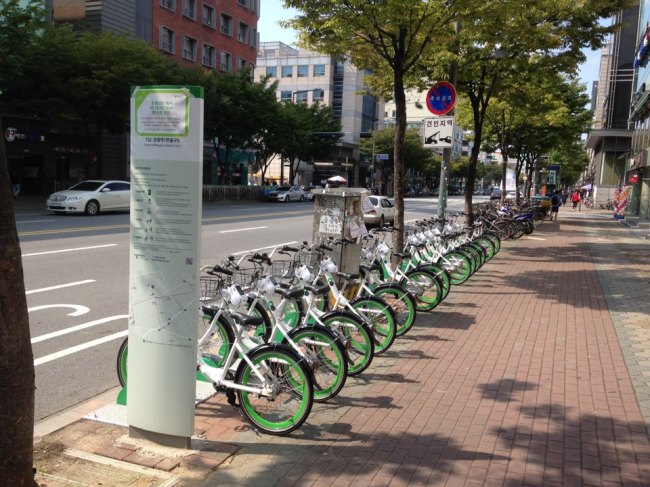Seoul City launched last week a new public bike-sharing service as part of its initiatives to reduce carbon emissions, although the project still faces the tasks of ensuring safety and promoting wider public participation.
Since Oct. 15, Seoul Metropolitan Government has offered a total of 1,200 public bikes called “Ddaleungee” at 140 docking stations in five major regions including Yeouido, Sinchon, Seongsu and central Seoul near Gwanghwamun.
 |
| Ddaleungee bikes are parked at a docking station near Mangwon Subway Station in Mapo, Seoul. (Seoul Metropolitan Government) |
For only 1,000 won ($0.90) a day, anyone aged 15 or older can ride a bike around the clock. The rental process is simple as the bike booking is available online or by a mobile application.
Those with a membership can use the service for much cheaper and accumulate mileage points when they transfer from the bike to public transportation within 30 minutes. The points can be used as cash when renting the bike.
The service is also available in foreign languages — English, Chinese and Japanese.
Foreigners can subscribe to the service by registering their M-pass number or T card number on the website. They must pay a deposit of 50,000 won for the bike sharing membership.
The city is planning to gradually increase the bike fleet to 20,000 by 2020 with more transportation transfer benefits.
The push for the public bike sharing has been one of Seoul Mayor Park Won-soon’s key green initiatives to reduce carbon emissions. The current city administration has strived to change the public perception toward bicycles in order to promote it as a basic means of public daily life.
As part of the efforts to boost bike use, the city has in recent years constructed bike-only roads spanning 180 kilometers between the five Ddaleungee service locations as well as a 70-kilometer stretch along the Hangang River for leisure purposes. As of this year, 724 kilometers of bike-only roads are installed in the capital, officials said.
Along with the bike-friendly infrastructure, the city government has put efforts into improving public perceptions toward the bike through various measures.
It has run free bike schools for bike beginners and provided bike safety classes for children at schools while holding various bike-related festivals and events across the city. Some city districts also offer free insurance packages for bike riders.
“The mayor has considered raising public perception as important as constructing enough bike infrastructure,” a city official told The Korea Herald.
Running a public bike-sharing service has long been a staple green project in metropolitan cities around the world, with about 530 municipalities having launched such projects.
In Paris, about 24,000 bikes are running in the city’s program, attracting more than 286,000 annual subscriptions since 2007. This is equivalent to 1 in 8 Parisians.
New York’s Citi Bike, the largest public bike share in the U.S., has drawn over 90,000 subscribers with 6,000 bikes across the city since 2013. The average day last year saw about 34,000 rides. The city is planning to increase the number of both bikes and docking stations by 2017.
While other cities have successfully led public bike sharing systems, questions linger over Seoul City’s scheme as a similar attempt in the past resulted in a disappointing outcome.
In 2010, the former Seoul City government led by Oh Se-hoon ran a bike project with 440 public bikes in Yeouido and Sangam. Facing the high cost and low public participation, however, the city soon scrapped it.
Expensive and heavy bikes posed challenges to the city as one bike, weighing 23 kilograms, cost 6.4 million won.
In order to lower the cost, the current city government led by Park Won-soon halved the bike cost by recycling and reassembling the existing bikes with lighter components.
It also eliminated the kiosks that were installed at docking stations for bike rental and instead introduced an online and mobile kiosk application service to save money. Installing one kiosk used to cost 20 million won, adding to the financial burden, officials said.
“While the system is much improved, it’s still uncertain how the public will respond to the new scheme. It’s optimistic, however, that the city at least attempted to ‘invite’ the public to ride bikes in downtown Seoul,” said urban planning and design professor Jeong Seok at University of Seoul.
“The use of transportation means depends on the public psychology. Making that very first attempt of riding a bike along the roads for cars may be challenging as bikers are the minority among the traffic. But they may gradually rise to become a major part of the traffic once the number of bike riders increases, consequently influencing the transportation measures.”
In order to successfully run Ddaleungee, civic groups stress that raising public awareness is crucial.
“Car drivers must acknowledge first that the roads are made for both automobiles and bikes. Some prevalent misperceptions that roads are only for car owners often leads to bike accidents on roads, stirring safety concerns for cyclists,” said civic group Green Transport manager Ko Moon-soo, who is in charge of bike issues.
The current transportation rule legally allows bike riders to use one-third of the right-most lane of the road, but many car drivers are not aware of the regulation, he added.
According to Rep. Byun Jae-ill of the New Politics Alliance for Democracy, the bike accident rate surged to some 4,100 cases in the capital last year, up 70 percent from 2010. This has led to 37 deaths and over 4,200 injured riders.
Of these cases, collisions with cars accounted for the most with 81 percent, followed by those with pedestrians with 10 percent, and accidents with other bikes at 8 percent.
By Lee Hyun-jeong (rene@heraldcorp.com)

